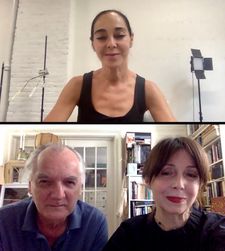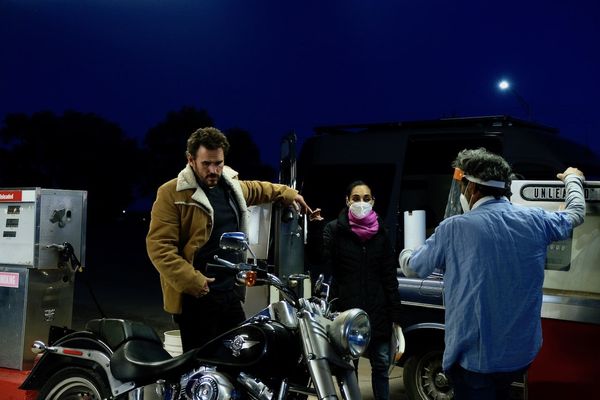 |
| Shirin Neshat with Matt Dillon and cinematographer Ghasem Ebrahimian on the set of Land Of Dreams, co-directed with Shoja Azari, screenplay by Jean-Claude Carrière and Azari Photo: Giulia Theodoli |
In the second instalment with Shirin Neshat we discuss the Sam Shepard look for Matt Dillon as Alan, Sheila Vand’s compulsive obsessive traits for Simin, Isabella Rossellini’s love of animals and her peacock screeches as Jane. Anna Gunn’s Betty and Nancy, William Moseley’s Mark, Luis Buñuel films, and the Jean-Claude Carrière narrative of how and why they are collecting dreams also came up. When music producer and 99 Records founder Ed Bahlman joined us, he inquired about Land of Dreams composer Michael Brook (Keith Behrman’s Giant Little Ones starring Kyle MacLachlan, John Crowley’s Brooklyn, based on a Colm Tóibín novel), the story about Little Pedro, the paintings in the film, and remarked on a Site Santa Fe Patti Smith concert.
Shirin Neshat and Shoja Azari’s highly imaginative Land Of Dreams, based on a story by Shirin Neshat, screenplay by Jean-Claude Carrière and Shoja Azari takes us on the road to the American Southwest of the near future, where an Iranian colony is nestled in the desert, and where a census bureau collects everyone’s dreams for the dreamers “security”.
From New York City, before the world premiere at the Venice Film Festival, Shirin Neshat joined me on Zoom for an in-depth conversation on Land Of Dreams, a highlight of the 21st edition of the Tribeca Film Festival.
Anne-Katrin Titze: Because I knew I was going to talk to you this morning, I remember my dream from last night. I was going to The Museum of Natural History to meet with Sam Shepard.
Shirin Neshat: Wow, my favourite!
AKT: I have to explain why he was on my mind, maybe because of New Mexico in your film, too. But I had recently watched a documentary called On Broadway [Oren Jacoby]. The director previously made a documentary called Sam Shepard: Stalking Himself. So Shepard was on my mind.
SN: That’s so funny because to me, Sam Shepard is one of the most attractive men on the planet, before he died.
AKT: I love that you said before he died!
SN: When we were doing the costume for Matt Dillon, I was doing research on my mood book for what ideally I wanted him to look like. It was Sam Shepard.
AKT: I can see that.
SN: Very masculine, western, with the cowboy hat. So I actually used a lot of references to him.
AKT: I spent an afternoon with him at Pastis. We met at a lunch at Le Cirque [for August: Osage County]. So I had one long afternoon with Sam Shepard, years ago.
SN: That is amazing. I would have loved to have met him. To me he was the sexiest man ever.
AKT: Very sexy, yes.
 |
| Shirin Neshat on Mark (William Moseley) with Simin (Sheila Vand) and Alan (Matt Dillon): “The first day he meets her he says I love you. Everything was off the wall.” Photo: Ghasem Ebrahimian |
SN: And he was a poet. I just loved him so much.
AKT: Speaking of Matt Dillon, you have The Ink Spots and Someone's Rocking My Dream Boat!
SN: I have to tell you a secret. When we were shooting that scene, Matt Dillon started to sing that song. We asked: ”What is that?” He said: ”Oh that’s a beautiful classic song.” Later when we were editing it, we said why not bring that song and have it come back. He started it.
AKT: The whole idea of the census is great. The fact that they say: We are collecting your dreams. It’s for your security! I was thinking of Until the End Of The World by Wim Wenders which has Jeanne Moreau obsessively looking at herself, at her dreams. He came up with the idea in the Eighties that we would become addicted to screens on which we watch our dreams over and over again.
SN: That’s a very good point. I have to say we had a few things in mind. First of all, the census bureau. The story is taking place in the near future. We thought about the census bureau as a combination between the mogul media corporations like Twitter and Facebook and Amazon and a kind of government census bureau. In a way it’s very scientific science fiction inside with all those computers, but the offices are these bureaucratic rooms with all these uniform people. I was thinking Kafkaesque,
AKT: Yes, yes.
SN: The idea of Big Brother looking over you. Also that Nancy [Anna Gunn as Simin’s boss] was dressed so elegantly and fashionably, while the rest of the people are not, so she represented not your typical bureaucratic office worker.
AKT: It is not actually the near future, it is what we already have. Advertising, algorithms are influencing your dreams. Not just taking your dreams, but producing dreams for you.
 |
| Shirin Neshat on Simin (Sheila Vand): “The simplicity and her style is something between Iranian and western, modern …” Photo: Ghasem Ebrahimian |
SN: I like what we do in our film with our small budget. On the one hand you have the very high-tech census office, but then you have the Iranian colony which is archaic, renegade, in a village. I wanted this combination of an ancient, old-fashioned, archaic, dated situation and then the almost futuristic, like Brazil [directed by Terry Gilliam].
AKT: Plus the American iconography! The motel she is in.
SN: The diner!
AKT: Even the car, although it’s a German car, her Mercedes. I like the black dresses Simin is wearing. Until later when she changes into a houndstooth skirt and for the first time is not wearing black. How her bag is placed on the chair is one of the details that make it more than just symbolism.
SN: Sheila Vand, the actress, she herself suggested that the character of Simin should be highly obsessive about where she puts things every day. If you look at her bedroom everything is in order. She is compulsive obsessive. The way she looked, I really cared about that. The simplicity and her style is something between Iranian and western, modern, but also not quite fitting with the rest of the American community. How did you feel about her performance?
AKT: I liked it very much, because it was so off at certain points. She seems to be taken aback. I saw her in A Girl Walks Home At Night.
SN: I was going to ask if you remembered her from that!
AKT: Yes, I remembered. I like her hesitancy, I like that it wasn’t actorly, which I really appreciate.
SN: What about Matt Dillon?
AKT: He is more than the song! And provides absurd comic relief. There he is with his motorcycle again!
SN: Like a horse.
AKT: It’s a good combination with the sincerity of the other actor whom I didn’t know.
 |
| Shirin Neshat on Sheila Vand as Betty: “The actress, she herself suggested that the character of Simin should be highly obsessive about where she puts things every day.” Photo: Ghasem Ebrahimian |
SN: Will Moseley, yes, he is young.
AKT: And who knew that Isabella Rossellini could make such wonderful peacock sounds!
SN: Well, she’s obsessed with animals, you know.
AKT: I do.
SN: I went to her farm on Long Island. Oh my god, you cannot believe how many birds she has! And other animals. It was perfect because there were horses and peacocks and she had a dog and that scene becomes very strange. It’s funny because we’re living since the pandemic on a lot of Zoom.
AKT: Indeed.
SN: One could imagine having dinners like that. A lot of people did that long-distance.
AKT: So she was actually elsewhere? You filmed it all during 2020?
SN: Yes, we filmed her separately. I can’t describe to you the challenges, because we had this one window of opportunity where New Mexico opened to film productions in the fall of 2020. So we drove from New York and some of the actors were really scared about coming. We shot the film in November and we were tested every other day and not a single person got ill. As soon as we finished the film, literally the day after, New Mexico closed for film productions again. It was a blessing that we managed to shoot the film with a very small amount of money, with a lot of challenges.
AKT: The story of the nightingale flying at night is a metaphor connected to the rest of the story. Is it an ancient tale?
SN: Yes. The intention was to have this film as a dark comedy, a kind of critique of American society, etc., but to have this other layer that is much more existential. A much more emotional and political state of people like Simin’s. Like my own experience as someone who is emotionally, psychologically, politically always conflicted between what I am as an Iranian and as an American. The language that was used by that old man in the colony and the reference to the nightingale which is all over the mysticism of Iranian poetry. The whole idea is what happens when it loses the nest and only flies at night when the nest is broken.
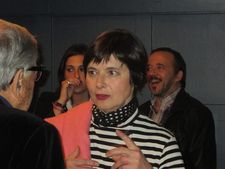 |
| Isabella Rossellini with Paolo Taviani at Soho House in New York Photo: Anne-Katrin Titze |
AKT:, I looked up your composer Michael Brook and what else he did. He did Giant Little Ones, with Kyle MacLachlan and Brooklyn.
SN: And Affliction, which was a beautiful film. What did you feel about the music?
AKT: It worked. At times it felt David Lynch-y.
SN: We thought it should be an American composer with an Americano, if you like, taste of music, because it takes place in the Southwest. The Europeans are always worried about too much music so we did take out a little bit. The music at the very end with the spiral is very emotional. Some of the string instrumentation with Simin and Mark driving the car in the beginning, it feels right, like a road trip. I really like his sensibility and it’s been a real pleasure working with him, Michael Brook.
Ed Bahlman [entering the Zoom to say hi and ask pertinent questions]: Who came up with Little Pedro?
SN [bursts out laughing]: Oh my god, I have to be very honest with you, Shoja, who really wrote the script with Jean-Claude, he saw this joke on the Internet. In the whole film there is so much bigotry, immigration is such a big subject. The way Jackie [Robin Bartlett] dreams about Mexicans coming into her house, remember?
AKT: Good visuals of the Day of the Dead accompany it.
SN: The fear of immigrants! When she goes to the three old men, that say “Where are you really from?” And then the joke about Little Pedro who is Mexican and knows more about American history, it just fit our story so well. The two people who refuse the census interview are a Black man and a Native American.
EB: Where are the paintings from?
SN: We commissioned a friend of mine to paint these, he’s an artist. We came up with ideas we took from African American painters and ancient classics. He’s a great Iranian painter [Nicky Nodjoumi] who took our mood book and then created them.
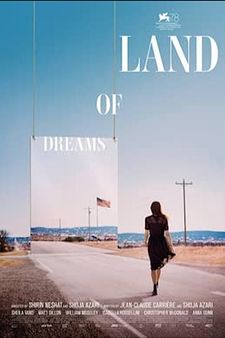 |
| Land Of Dreams poster |
EB: How did Michael Brook score the film? Where did he record it?
SN: Michael is based in LA. We started virtually and then I went to LA and met with him. You know, the editing was virtual, a lot of it was because of the pandemic. He did it all through his studio. I know with Ryuichi Sakamoto with my last film he really recorded with an orchestra, the score for Women Without Men. Michael didn’t.
EB: Are you keeping I Only Have Eyes For You [by The Flamingos] in the diner?
SN: Yes, and we’re keeping all the Persian songs that you heard. Also the Marilyn Monroe song. You are actually some of the first people I talk to about the film!
AKT: I have a question about the rules she establishes at the beginning. You have to tell your dream twice! With Betty [played by Anna Gunn], when she speaks of her legs, she says cherry-red. The next time it turns into blood-red. I loved that shift that happens when you retell. Then the theme of her translating it into Farsi and performing the dreams.
SN: I’m so glad, because what was our intention, as cartoonish as the blond woman [Betty, played by Anna Gunn] was, she’s also very tragic. She obviously was obsessed with her superficial look but deeply she was very unhappy. The second time she is almost in tears. The blood maybe represents the end of her fertility, because she is so obsessed with her looks and youth and a lot of women are like that. She’s obviously unhappy in her relationship.
The first time she describes it it doesn’t include any of this anxiety, these fears. For me these dreams at least in the film are projections of people’s fears. Isabella [as Jane], or even Jackie, every dream that is told. By telling it the second time it becomes very honest. So Jean-Claude created this narrative of how and why they are collecting dreams. The conversation between Simin and Mark in the car where he asks ”Are they made public?” She says: “ They should be, I think for psychologists, scientists, and artists!” And he says “What about priests?”
AKT: No, they should not get them, she says!
SN: This is Jean-Claude! Priests are only after sins and confessions. And then: Dreams vanish so quickly and then they become a story! Jean-Claude always used to say, if you don’t write down the dream, forget it. And you start making things up like beginning middle and the end, because dreams don’t have a beginning, middle and end. Some people may not get all these nuances, but this is really Jean-Claude’s touch.
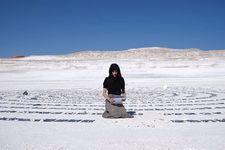 |
| Shirin Neshat on Simin (Sheila Vand): “She is compulsive obsessive. The way she looked, I really cared about that.” Photo: Ghasem Ebrahimian |
AKT: His past films seem to be floating in and out of this one. Belle de Jour, the maid’s outfits.
SN: Do you remember the Buñuel film where two different women played the same character? And they didn’t even look the same!
AKT: Yes, That Obscure Object of Desire.
SN: That’s it. Two separate women playing the same character, I could not believe that. Jean-Claude said it’s because they were casting and Buñuel liked both of them and he didn’t want to drop one.
EB: How did you shoot these scenes? Mark always seems to be going in the opposite direction. There’s Alan again in front on the motorcycle. He’s pissed off that she stopped again. Mark says to her “I knew it was you.” How could he not know it was her with Alan in front? That’s beautiful timing. Did you do this in one take?
SN: We did a few takes. That was also Jean-Claude’s text. Or the way he appeared in the colony. So there’s a huge mystery about him. I have to be honest, a lot of people are thrown off by Mark, but the way we developed his character was like there’s no description how he gets around. He doesn’t fit into that small town. The way he falls in love with this girl he never has seen before. The first day he meets her he says I love you. Everything was off the wall.
EB: Also New Mexico. In the Eighties and Nineties I knew Santa Fe pretty well. Did you ever do an exhibition at Site Santa Fe?
SN: It’s funny that you say that. I’m having an exhibition at Site Santa Fe next year [2022]. The work that I did related to Land of Dreams. Artwork, also shot in New Mexico.
EB: In 1997 they wanted to have Patti Smith perform at their benefit gala and Louis Grachos …
SN: … who is organising my show now!
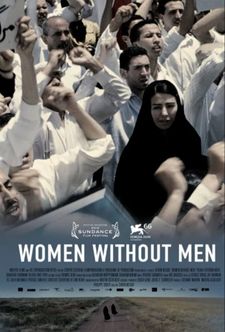 |
| Ryuichi Sakamoto did the score for Shirin Neshat’s Women Without Men (winner of the Silver Lion in Venice, 2009) |
EB: He contacted me because we had met prior and said “I’m getting all those mixed messages from her people, we really need her to come.” So I called Lenny Kaye, her guitarist and I said have you heard about the opportunity to perform at Site Santa Fe? No, he hadn’t heard about it. So he got to Patti. I arranged it, I flew down there to make sure the sound was alright. So I was the intermediary. It worked out really well for them. All the young artists were there of course. They printed fake money with Patti Smith on the dollars and threw it when she did the song Free Money.
SN: That’s amazing. You know Louis had left Site Santa Fe for years and went to Santa Barbara and he’s just back.
EB: Officially back?
SN: Officially back, I talked to him just yesterday. I have to tell him the story.
EB: I haven’t been in contact with him for a long time!
SN: It’s such a funny story you’re telling me. The thing about Mark’s character, whenever you go to small towns you meet that person. Even though all his life he has lived in this small town, he is always thinking about the rest of the world. He has never travelled anywhere. There’s always these oddballs you meet.
EB: Also the Santa Fe connection, one of the oddballs reminded me of Mark’s behavior. I met Noguchi’s nephew. He didn’t seem to talk to anybody else in the downtown cafés, but he’d sit down at my table and he would tell me all these stories. I told him that when I was young this life insurance guy met with me and told me “You know Ed, it doesn’t pay to know too much.” And Noguchi’s nephew said ”Ed, he was right, you knew enough.”
SN: That is really weird. I like characters like that.
AKT: They make good movie characters. I was thinking of Chekhov’s Three Sisters who always want to go to Moscow and never make it. The longing for elsewhere in small-town characters.
SN: Then they get a foreigner like Simin and their radar goes up because she represents the outside world.
 |
| Shirin Neshat with 99 Records founder Ed Bahlman at the 2nd annual FFFEST inside the Quad Cinema Photo: Anne-Katrin Titze |
AKT: Thank you so much for this!
SN: So much fun talking to you guys, you made my day. I really enjoyed chatting with the two of you this morning! Your apartment looks beautiful. I hope to see you soon! Thank you so much for your interest in the film.
EB: Say hi to Shoja!
SN: I will do that! Take care!
Read what Shirin Neshat had to say on Jean-Claude Carrière and Land Of Dreams.
Land Of Dreams is available for viewing on the Tribeca Film Festival At Home platform through June 26.








